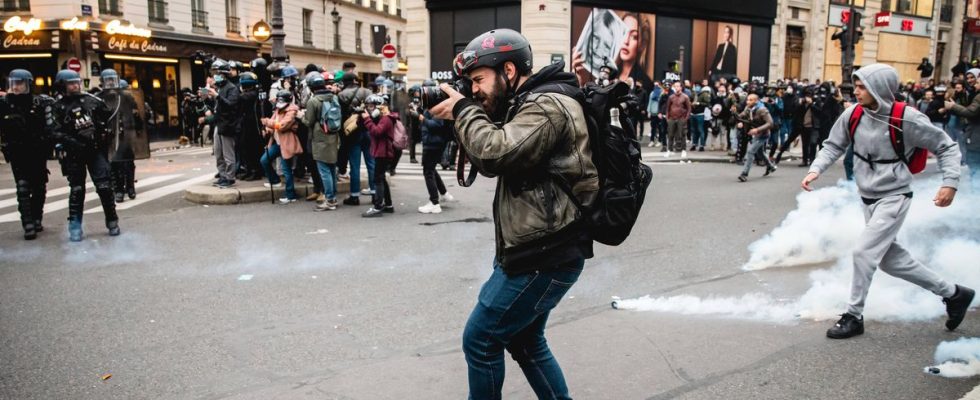In recent weeks, on social networks, they have multiplied like hot cakes. To the point of doubting many Internet users. They are the false images generated by artificial intelligence tools, named Midjourney or Dall-E. If those of Emmanuel Macron demonstrating against his own pension reform, arrested by the police or dressed as a garbage collector leave little doubt about their origin – so surreal are they -, others are more plausible and pose real ethical problems.
Especially since the two tools are now available in open beta version, that is to say accessible to everyone. It only takes one descriptive sentence to create a truer-than-life fake image. “The models are improving at breakneck speed. In one year, the progress made is enormous. There are still a few artifacts, but they are very realistic,” concedes Virginie Mathivet, director of the Data Science and Engineering department at TeamWork. And it’s Midjourney that wins the prize, according to Olivier Zetlers, co-founder of Yokai.ai, a French start-up expert in generative AI: “It is certainly the best model in the world. The latest version, posted online in mid-March, has exceeded the expectations of many, especially in terms of photorealism, it is stunning”.
“It will be necessary to start from the principle that a photo is false”
For the moment, certain details still make it possible to detect that these are false images, such as hands with six fingers, eyes of different colors or asymmetrical faces. “There are still inconsistencies, but it will be resolved quickly. It’s more a matter of weeks than months, moreover, ”says Olivier Zetlers. And for Virginie Mathivet, it will soon be difficult, if not impossible, to tell the difference between a photograph taken by a journalist and a false image generated by an artificial intelligence tool. “Soon, it will be necessary to start from the principle that a photo is false. The adage, “I only believe what I see”, will soon no longer be possible”, she warns.
But for the engineer, it must be kept in mind that even with progress and extreme realism, these images generated by artificial intelligence tools will remain illustrations: “We will be able to create images that are more real than life , but it will not be photo, it will be realistic illustration. There will always be differences,” she explains. “Artificial intelligence is still mimicry taken to the extreme. These tools do not produce original or unique photos”, adds Olivier Zetlers.
Especially since “fake photos” are not new, reminds the specialist: “Hyperrealistic photomontages, we were already doing them ten years ago with Photoshop. On social networks, there are every day. The only difference now, according to the co-founder of Yokai.ai, is that with artificial intelligence, the tools are accessible to everyone and these images are realized in seconds.
“A photo is a story of the person who lived it”
This is enough to worry photoreporters, who may fear that their work will be replaced by images generated by artificial intelligence. For Jean Rognetta, journalist and co-founder of Quantitya daily technological newsletter written and illustrated using several “generative” artificial intelligence (AI) tools, “all professions relating to the generation of content will be profoundly upset, including photojournalists”.
Despite these changes, there is no question of speaking of a “great replacement”, according to the former editor-in-chief of Forbes France. “All the AIs in the world will not be able to replace photojournalists, because their specificity is to be able to say ‘I was there, I saw, I can tell'”. And for Jean Rognetta, what makes a photo exceptional “is also the courage and risk-taking of its photographer” who can find himself in dangerous situations.
Because the very essence of a photographer is to witness a fact, unlike images generated by artificial intelligence, according to Olivier Zetlers: “The added value of the photojournalist is to capture a image of a fact that really happened, the reality of the moment. He really went on the field, he really pressed the goal, he really witnessed”. Without forgetting, recalls Virginie Mathivet, the notion of memory of a photograph: “If we take the famous photo of the demonstrator in front of the Tiananmen tanks, by photographing this moment and this man, the journalist has made it possible to preserve the memory of the latter , of what he has experienced”, explains the engineer.
“More an opportunity than a risk for the media”
If there is one point on which the three specialists agree, it is the importance of knowing how to spot “false” images from real photographs. “It’s a matter of pedagogy, education and awareness. People need to be able to reliably, reasonably and ethically authenticate the real work of journalists, to make a difference with an image generated by AI”, analyzes Olivier Zetlers. Because the risk is “to generate paralyzing effects”. In other words, the population no longer believes in the authenticity of a photograph and assumes that they are all fake: “Little by little, people could lose residual trust in the media, it could erode,” fears Jean Rognetta.
And for the journalist, the media will have a responsibility: “It’s a question of ethics. Media should make sure to publish real photographs and if not, mention that it is an image generated by artificial intelligence. It has to be very clear”. A responsibility which could also be an opportunity for the media to restore trust with the general public, believes Virginie Mathivet: “It can be more of an opportunity than a risk for the media, to return to the front of the stage, to reclaiming their primary role, that of carrying information. It will be a beacon that will say: this is the real news”.

